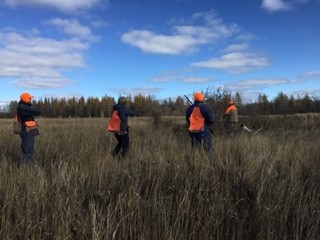Darold Biette and his wife found themselves looking for a new enterprise a decade and a half ago, but they had no idea at the time it would lead to a pheasant hunt farm near Mistatim, SK.
“We were trucking in Estevan and life just called for some changes, so we sold out down there and moved north,” Biette explained as he took a break from putting up his booth at the Parkland Outdoor Show & Expo Friday.
The couple’s initial idea was to purchase an outfitting camp.
“I guided in four provinces for big game and migratory birds,” he said, adding he had worked with and bred pointing dogs dating back to 1990.
But the thought of an outfitting camp never quite materialized.
Instead they found themselves at Mistatim breeding English pointers and Brittany spaniels, and operating a trap line.
With hunting dogs already a passion the idea of starting a pheasant hunt farm began to percolate a decade ago.
“We needed something to fill in a bit,” in terms of their work year, said Biette.
Biette said from the time of the idea it took two years to manoeuvre through the rules and regulations in Saskatchewan to get the farm off the ground.
“It took us two years to get government approval,” he explained, adding they were fortunate to have some help along the way.
“We were lucky we had a really good conservation officer in our area,” he said, adding the CO was instrumental in helping them navigate the regulations.
But they made it through the provincial red tape and eight years ago Pheasant Point Adventures was launched. The business hunts only family owned land that is farmed and managed to increase the quality of your pheasant hunt.
Biette explained they purchase 1500-2000 day-old pheasants that are flown in from Quebec each year.
The pheasants are raised on a high protein diet specifically made for pheasants until they mature to full grown at 12 weeks of age. At that time the birds are weaned from the prepared feed to a more traditional diet of grain seeds fed on the ground. Biette explained it is important to give the birds the ability to forage in the wild after release.
At about 16 weeks the birds are ready for a hunt.
“We release birds into the field early in the morning,” said Biette, adding they are allowed some time to nestle down into the natural setting before a hunt. “Then we hope on a wing and a prayer they’re there when we go out” pointing out at times the birds have moved off. That is why they prepare the birds to survive in the wild, because those not hunted have a chance to survive.
As part of the service hunters buying a day hunt are hunted over the Biette’s gun dogs, although those with their own dogs can use them.
Biette said they actually have their dogs trained a bit differently. Whereas most hunters flush over their pointers at some distance, they “creep the dogs closer to the birds” to afford better shots, something they started when providing hunts for the disabled.
“It’s been a definite challenge,” he said, adding it has proven a good move to make hunts more successful for their clients.
Hunts are held from September through until December unless too much snow arrives early. In 2018 the season ended in November. Biette estimated they hunt 800-1000 pheasant a year, the majority of clients being from Saskatchewan.
Biette said the hunts have been a success because there is a sense of adventure when out looking for the pheasant which are still not easy to bag even though they were farm-raised.
“We make it an adventure,” he said, adding people do not need provincial licenses to hunt on the farm which makes it an easier option for many.
“It’s not just about hunting birds, it’s about spending time in the field,” he said.
Check out the farm at www.pheasantpoint.ca



